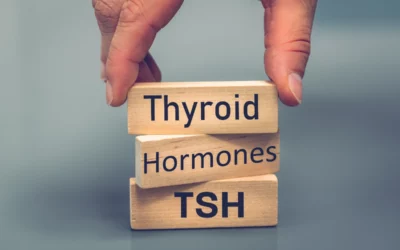Hashimoto’s disease is an autoimmune disorder that affects the thyroid gland. It can have serious health consequences for the individuals concerned and cause problems that prevent the body from working properly. As Hashimoto’s thyroiditis is a complex condition, it is essential to understand some of its hallmark features such as hypothyroidism, to better understand its impact on health. Discover all you need to know about thyroid disease and how to effectively manage this common condition, which particularly affects women.
What is Hashimoto’s disease?
Hashimoto’s disease – also known as chronic thyroiditis or lymphocytic thyroiditis, was discovered by the Japanese doctor Hakaru Hashimoto in 1912. Like Graves’ disease, it is an autoimmune condition that affects the thyroid gland, a small butterfly-shaped gland at the base of the neck. When you have this condition, your body’s immune system will attack the thyroid, causing inflammation and gradually destroying the thyroid cells. This can reduce the production of essential hormones and therefore increase the risk of hypothyroidism.
According to the American Thyroid Association, this condition can affect people of any age, but it is more common in women, especially over the age of 50. However, hypothyroidism in men, although less frequent, requires proper diagnosis and treatment.
Genetic factors seem to play a key role in the development of the condition, although the exact mechanisms are not yet fully understood. Its appearance could also be associated with some environmental agents, but also with iodine deficiency or some medicines.
Hashimoto’s thyroiditis: what are the symptoms?
The symptoms associated with this condition can vary and progress slowly, making it difficult to identify in the early stages. The most common signs observed in Hashimoto’s disease include:
- Goitre
- Hypothyroidism
- Persistent tiredness
- Hypothermia
- Slower heart rate
- Unexplained weight gain, despite a balanced diet and adequate levels of physical activity
- Increased sensitivity to cold
- Dry, rough or dehydrated skin due to a reduction in thyroid hormones
- Constipation
- Swelling of the face
- Mood disorders, irritability or anxiety
- Significant and unusual hair loss
- Menstrual problems
What causes Hashimoto’s Disease?
Lymphocytic thyroiditis is an autoimmune condition, which means that the body’s immune system mistakenly attacks its own tissues, the thyroid gland in this case. However, the exact cause of this type of reaction may be due to a number of factors. Several factors are thought to be involved in the development of chronic Hashimoto’s thyroiditis.
A family medical history of autoimmune diseases can increase the risk of developing this condition. Some people may have a genetic predisposition that make them more likely to develop hypothyroidism. Hashimoto’s thyroiditis can also be caused by exposure to radioactive iodine treatment, viruses or infectious agents, some environmental toxins or even changes in diet.
How is it diagnosed?
Diagnosing Hashimoto’s disease generally requires several tests. Firstly, it is essential to establish the exact nature of the symptoms and collect information about the patient’s medical history, including any family history of thyroid or autoimmune conditions.
To make the diagnosis, the doctor will perform a thorough physical examination, which includes a palpation of the neck to look for characteristic physical signs such as swelling of the thyroid gland (goitre) or other abnormalities.
The first series of tests will include blood tests for thyroid hormones and thyroid antibodies. These blood tests will measure levels of TSH (thyroid stimulating hormone), T4 (thyroxine) and anti-thyroid antibodies, such as anti-thyroglobulin (anti-Tg) and anti-thyroid peroxidase (anti-TPO). High levels of anti-thyroid antibodies associated with low levels of TSH and/or T4 are often suggestive of lymphocytic thyroiditis.
The final diagnosis of Hashimoto’s thyroiditis requires an ultrasound scan of the thyroid and, in rare cases, a scintigraphy scan to take a look at the gland and assess its appearance, size and presence of nodules or other abnormalities.
Read also : Understanding the thyroid dysfunction : signs and symptoms
What are the treatments for Hashimoto’s Disease?
The main aim of treating Hashimoto’s disease is to compensate for the thyroid hormone deficiency (i.e. hypothyroidism), control symptoms and slow down the progression of the disease.
Hormone replacement therapy
The first-line treatment for lymphocytic thyroiditis is hormone replacement therapy. This involves taking synthetic thyroid hormone-based medicines, generally Levothyrox. Medicinal treatments help overcome the thyroid hormone deficiency, thereby improving the symptoms of hypothyroidism such as fatigue, weight gain, and sensitivity to cold. Dosage will be adjusted by the doctor according to the level of hormones in the blood.
Regular medical monitoring is important to adjust the dose of the medicine according to the patient’s individual needs. Regular consultations are also necessary to monitor thyroid function and antibody levels. Visits to an endocrinologist can also detect any problems or complications.
Balanced diet
Eating a balanced and nutrient-rich diet is important for healthy thyroid function. Some nutrients, including iodine and selenium, can be beneficial for the thyroid, but it is essential to consult a health professional before taking food supplements. To find out more about the different diets for Hashimoto’s disease, read our dedicated article.
Equally, regular exercise can boost the metabolism and reduce the tiredness associated with hypothyroidism.
Managing stress
Stress can exacerbate the symptoms of Hashimoto’s disease. Managing stress through relaxation techniques, meditation or other soothing activities can be helpful.
Surgery
In rare cases, when a thyroid goitre becomes very large and causes symptoms such as breathing difficulties or compresses the surrounding structures, surgery may be considered to remove part or all of the thyroid (thyroidectomy). To learn more about the thyroid gland surgery, read our dedicated article.
Did you know ? In France, thyroid disease affects around 15% of the population. Surgery may be indicated in the presence of nodules, thyroid cancer or an enlarged goitre. Today, FLUOPTICS© Part of Getinge is improving the surgical management of thyroid disorders thanks to the FLUOBEAM® LX device, autofluorescence technology, designed to reduce the inherent risks of such procedures.
Hashimoto’s disease is an autoimmune condition and therefore needs to be picked up early and managed appropriately to improve the quality of life of patients. Understanding the characteristic signs, hormone treatments, as well as raising awareness, are all key to improving the management of this condition in order to offer adequate support to those affected. Research is helping to broaden our healthcare know-how and is opening up new prospects to better support patients throughout their care pathway.




